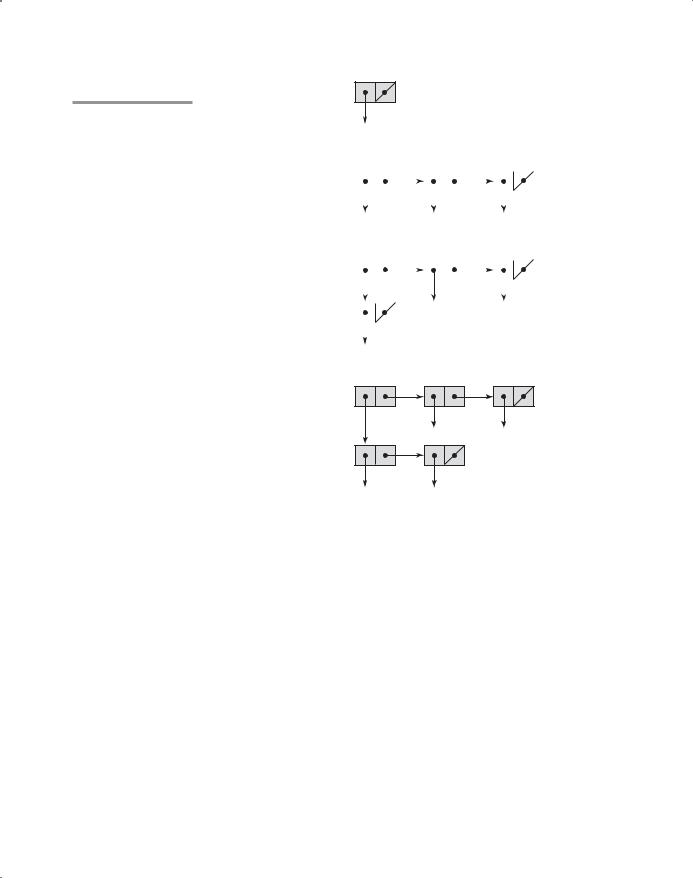
- •New to the Tenth Edition
- •Preface
- •Acknowledgments
- •About the Author
- •Contents
- •1.1 Reasons for Studying Concepts of Programming Languages
- •1.2 Programming Domains
- •1.3 Language Evaluation Criteria
- •1.4 Influences on Language Design
- •1.5 Language Categories
- •1.6 Language Design Trade-Offs
- •1.7 Implementation Methods
- •1.8 Programming Environments
- •Summary
- •Problem Set
- •2.1 Zuse’s Plankalkül
- •2.2 Pseudocodes
- •2.3 The IBM 704 and Fortran
- •2.4 Functional Programming: LISP
- •2.5 The First Step Toward Sophistication: ALGOL 60
- •2.6 Computerizing Business Records: COBOL
- •2.7 The Beginnings of Timesharing: BASIC
- •2.8 Everything for Everybody: PL/I
- •2.9 Two Early Dynamic Languages: APL and SNOBOL
- •2.10 The Beginnings of Data Abstraction: SIMULA 67
- •2.11 Orthogonal Design: ALGOL 68
- •2.12 Some Early Descendants of the ALGOLs
- •2.13 Programming Based on Logic: Prolog
- •2.14 History’s Largest Design Effort: Ada
- •2.15 Object-Oriented Programming: Smalltalk
- •2.16 Combining Imperative and Object-Oriented Features: C++
- •2.17 An Imperative-Based Object-Oriented Language: Java
- •2.18 Scripting Languages
- •2.19 The Flagship .NET Language: C#
- •2.20 Markup/Programming Hybrid Languages
- •Review Questions
- •Problem Set
- •Programming Exercises
- •3.1 Introduction
- •3.2 The General Problem of Describing Syntax
- •3.3 Formal Methods of Describing Syntax
- •3.4 Attribute Grammars
- •3.5 Describing the Meanings of Programs: Dynamic Semantics
- •Bibliographic Notes
- •Problem Set
- •4.1 Introduction
- •4.2 Lexical Analysis
- •4.3 The Parsing Problem
- •4.4 Recursive-Descent Parsing
- •4.5 Bottom-Up Parsing
- •Summary
- •Review Questions
- •Programming Exercises
- •5.1 Introduction
- •5.2 Names
- •5.3 Variables
- •5.4 The Concept of Binding
- •5.5 Scope
- •5.6 Scope and Lifetime
- •5.7 Referencing Environments
- •5.8 Named Constants
- •Review Questions
- •6.1 Introduction
- •6.2 Primitive Data Types
- •6.3 Character String Types
- •6.4 User-Defined Ordinal Types
- •6.5 Array Types
- •6.6 Associative Arrays
- •6.7 Record Types
- •6.8 Tuple Types
- •6.9 List Types
- •6.10 Union Types
- •6.11 Pointer and Reference Types
- •6.12 Type Checking
- •6.13 Strong Typing
- •6.14 Type Equivalence
- •6.15 Theory and Data Types
- •Bibliographic Notes
- •Programming Exercises
- •7.1 Introduction
- •7.2 Arithmetic Expressions
- •7.3 Overloaded Operators
- •7.4 Type Conversions
- •7.5 Relational and Boolean Expressions
- •7.6 Short-Circuit Evaluation
- •7.7 Assignment Statements
- •7.8 Mixed-Mode Assignment
- •Summary
- •Problem Set
- •Programming Exercises
- •8.1 Introduction
- •8.2 Selection Statements
- •8.3 Iterative Statements
- •8.4 Unconditional Branching
- •8.5 Guarded Commands
- •8.6 Conclusions
- •Programming Exercises
- •9.1 Introduction
- •9.2 Fundamentals of Subprograms
- •9.3 Design Issues for Subprograms
- •9.4 Local Referencing Environments
- •9.5 Parameter-Passing Methods
- •9.6 Parameters That Are Subprograms
- •9.7 Calling Subprograms Indirectly
- •9.8 Overloaded Subprograms
- •9.9 Generic Subprograms
- •9.10 Design Issues for Functions
- •9.11 User-Defined Overloaded Operators
- •9.12 Closures
- •9.13 Coroutines
- •Summary
- •Programming Exercises
- •10.1 The General Semantics of Calls and Returns
- •10.2 Implementing “Simple” Subprograms
- •10.3 Implementing Subprograms with Stack-Dynamic Local Variables
- •10.4 Nested Subprograms
- •10.5 Blocks
- •10.6 Implementing Dynamic Scoping
- •Problem Set
- •Programming Exercises
- •11.1 The Concept of Abstraction
- •11.2 Introduction to Data Abstraction
- •11.3 Design Issues for Abstract Data Types
- •11.4 Language Examples
- •11.5 Parameterized Abstract Data Types
- •11.6 Encapsulation Constructs
- •11.7 Naming Encapsulations
- •Summary
- •Review Questions
- •Programming Exercises
- •12.1 Introduction
- •12.2 Object-Oriented Programming
- •12.3 Design Issues for Object-Oriented Languages
- •12.4 Support for Object-Oriented Programming in Smalltalk
- •12.5 Support for Object-Oriented Programming in C++
- •12.6 Support for Object-Oriented Programming in Objective-C
- •12.7 Support for Object-Oriented Programming in Java
- •12.8 Support for Object-Oriented Programming in C#
- •12.9 Support for Object-Oriented Programming in Ada 95
- •12.10 Support for Object-Oriented Programming in Ruby
- •12.11 Implementation of Object-Oriented Constructs
- •Summary
- •Programming Exercises
- •13.1 Introduction
- •13.2 Introduction to Subprogram-Level Concurrency
- •13.3 Semaphores
- •13.4 Monitors
- •13.5 Message Passing
- •13.6 Ada Support for Concurrency
- •13.7 Java Threads
- •13.8 C# Threads
- •13.9 Concurrency in Functional Languages
- •13.10 Statement-Level Concurrency
- •Summary
- •Review Questions
- •Problem Set
- •14.1 Introduction to Exception Handling
- •14.2 Exception Handling in Ada
- •14.3 Exception Handling in C++
- •14.4 Exception Handling in Java
- •14.5 Introduction to Event Handling
- •14.6 Event Handling with Java
- •14.7 Event Handling in C#
- •Review Questions
- •Problem Set
- •15.1 Introduction
- •15.2 Mathematical Functions
- •15.3 Fundamentals of Functional Programming Languages
- •15.4 The First Functional Programming Language: LISP
- •15.5 An Introduction to Scheme
- •15.6 Common LISP
- •15.8 Haskell
- •15.10 Support for Functional Programming in Primarily Imperative Languages
- •15.11 A Comparison of Functional and Imperative Languages
- •Review Questions
- •Problem Set
- •16.1 Introduction
- •16.2 A Brief Introduction to Predicate Calculus
- •16.3 Predicate Calculus and Proving Theorems
- •16.4 An Overview of Logic Programming
- •16.5 The Origins of Prolog
- •16.6 The Basic Elements of Prolog
- •16.7 Deficiencies of Prolog
- •16.8 Applications of Logic Programming
- •Review Questions
- •Programming Exercises
- •Bibliography
- •Index

15.5 An Introduction to Scheme |
681 |
15.5 An Introduction to Scheme
In this section, we describe the core part of Scheme (Dybvig, 2003). We have chosen Scheme because it is relatively simple, it is popular in colleges and universities, and Scheme interpreters are readily available (and free) for a wide variety of computers. The version of Scheme described in this section is Scheme 4. Note that this section covers only a small part of Scheme, and it includes none of Scheme’s imperative features.
15.5.1Origins of Scheme
The Scheme language, which is a dialect of LISP, was developed at MIT in the mid-1970s (Sussman and Steele, 1975). It is characterized by its small size, its exclusive use of static scoping, and its treatment of functions as first-class entities. As first-class entities, Scheme functions can be the values of expressions, elements of lists, passed as parameters, and returned from functions. Early versions of LISP did not provide all of these capabilities.
As an essentially typeless small language with simple syntax and semantics, Scheme is well suited to educational applications, such as courses in functional programming, and also to general introductions to programming.
Most of the Scheme code in the following sections would require only minor modifications to be converted to LISP code.
15.5.2The Scheme Interpreter
A Scheme interpreter in interactive mode is an infinite read-evaluate-print loop (often abbreviated as REPL). It repeatedly reads an expression typed by the user (in the form of a list), interprets the expression, and displays the resulting value. This form of interpreter is also used by Ruby and Python. Expressions are interpreted by the function EVAL. Literals evaluate to themselves. So, if you type a number to the interpreter, it simply displays the number. Expressions that are calls to primitive functions are evaluated in the following way: First, each of the parameter expressions is evaluated, in no particular order. Then, the primitive function is applied to the parameter values, and the resulting value is displayed.
Of course, Scheme programs that are stored in files can be loaded and interpreted.
Comments in Scheme are any text following a semicolon on any line.
15.5.3Primitive Numeric Functions
Scheme includes primitive functions for the basic arithmetic operations. These are +, −, *, and /, for add, subtract, multiply, and divide. * and + can have zero or more parameters. If * is given no parameters, it returns 1; if + is given no parameters, it returns 0. + adds all of its parameters together. * multiplies all

682 |
Chapter 15 Functional Programming Languages |
its parameters together. / and − can have two or more parameters. In the case of subtraction, all but the first parameter are subtracted from the first. Division is similar to subtraction. Some examples are:
Expression |
|
Value |
||
42 |
|
|
|
42 |
(* 3 |
7) |
|
21 |
|
(+ 5 |
7 8) |
20 |
||
(− 5 |
6) |
|
−1 |
|
(− 15 |
7 |
2) |
6 |
|
(− 24 |
(* 4 3)) |
12 |
||
There are a large number of other numeric functions in Scheme, among them MODULO, ROUND, MAX, MIN, LOG, SIN, and SQRT. SQRT returns the square root of its numeric parameter, if the parameter’s value is not negative. If the parameter is negative, SQRT yields a complex number.
In Scheme, note that we use uppercase letters for all reserved words and predefined functions. The official definition of the language specifies that there is no distinction between uppercase and lowercase in these. However, some implementations, for example DrRacket’s teaching languages, require lowercase for reserved words and predefined functions.
If a function has a fixed number of parameters, such as SQRT, the number of parameters in the call must match that number. If not, the interpreter will produce an error message.
15.5.4Defining Functions
A Scheme program is a collection of function definitions. Consequently, knowing how to define these functions is a prerequisite to writing the simplest program. In Scheme, a nameless function actually includes the word LAMBDA, and is called a lambda expression. For example,
(LAMBDA (x) (* x x))
is a nameless function that returns the square of its given numeric parameter. This function can be applied in the same way that named functions are: by placing it in the beginning of a list that contains the actual parameters. For example, the following expression yields 49:
((LAMBDA (x) (* x x)) 7)
In this expression, x is called a bound variable within the lambda expression. During the evaluation of this expression, x is bound to 7. A bound variable

15.5 An Introduction to Scheme |
683 |
never changes in the expression after being bound to an actual parameter value at the time evaluation of the lambda expression begins.
Lambda expressions can have any number of parameters. For example, we could have the following:
(LAMBDA (a b c x) (+ (* a x x) (* b x) c))
The Scheme special form function DEFINE serves two fundamental needs of Scheme programming: to bind a name to a value and to bind a name to a lambda expression. The form of DEFINE that binds a name to a value may make it appear that DEFINE can be used to create imperative language–style variables. However, these name bindings create named values, not variables.
DEFINE is called a special form because it is interpreted (by EVAL) in a different way than the normal primitives like the arithmetic functions, as we shall soon see.
The simplest form of DEFINE is one used to bind a name to the value of an expression. This form is
(DEFINE symbol expression)
For example,
(DEFINE pi 3.14159)
(DEFINE two_pi (* 2 pi))
If these two expressions have been typed to the Scheme interpreter and then pi is typed, the number 3.14159 will be displayed; when two_pi is typed, 6.28318 will be displayed. In both cases, the displayed numbers may have more digits than are shown here.
This form of DEFINE is analogous to a declaration of a named constant in an imperative language. For example, in Java, the equivalents to the above defined names are as follows:
final float PI = 3.14159;
final float TWO_PI = 2.0 * PI;
Names in Scheme can consist of letters, digits, and special characters except parentheses; they are case insensitive and must not begin with a digit.
The second use of the DEFINE function is to bind a lambda expression to a name. In this case, the lambda expression is abbreviated by removing the word LAMBDA. To bind a name to a lambda expression, DEFINE takes two lists as parameters. The first parameter is the prototype of a function call, with the function name followed by the formal parameters, together in a list. The second list contains an expression to which the name is to be bound. The general form of such a DEFINE is4
4.Actually, the general form of DEFINE has as its body a list containing a sequence of one or more expressions, although in most cases only one is included. We include only one for simplicity’s sake.

684 |
Chapter 15 Functional Programming Languages |
(DEFINE (function_name parameters) (expression)
)
Of course, this form of DEFINE is simply the definition of a named function. The following example call to DEFINE binds the name square to a func-
tional expression that takes one parameter:
(DEFINE (square number) (* number number))
After the interpreter evaluates this function, it can be used, as in
(square 5)
which displays 25.
To illustrate the difference between primitive functions and the DEFINE special form, consider the following:
(DEFINE x 10)
If DEFINE were a primitive function, EVAL’s first action on this expression would be to evaluate the two parameters of DEFINE. If x were not already bound to a value, this would be an error. Furthermore, if x were already defined, it would also be an error, because this DEFINE would attempt to redefine x, which is illegal. Remember, x is the name of a value; it is not a variable in the imperative sense.
Following is another example of a function. It computes the length of the hypotenuse (the longest side) of a right triangle, given the lengths of the two other sides.
(DEFINE (hypotenuse side1 side2)
(SQRT(+(square side1)(square side2)))
)
Notice that hypotenuse uses square, which was defined previously.
15.5.5Output Functions
Scheme includes a few simple output functions, but when used with the interactive interpreter, most output from Scheme programs is the normal output from the interpreter, displaying the results of applying EVAL to top-level functions.
Scheme includes a formatted output function, PRINTF, which is similar to the printf function of C.
Note that explicit input and output are not part of the pure functional programming model, because input operations change the program state and output operations have side effects. Neither of these can be part of a pure functional language.

15.5 An Introduction to Scheme |
685 |
15.5.6Numeric Predicate Functions
A predicate function is one that returns a Boolean value (some representation of either true or false). Scheme includes a collection of predicate functions for numeric data. Among them are the following:
Function |
Meaning |
= |
Equal |
<> |
Not equal |
> |
Greater than |
< |
Less than |
>= |
Greater than or equal to |
<= |
Less than or equal to |
EVEN? |
Is it an even number? |
ODD? |
Is it an odd number? |
ZERO? |
Is it zero? |
Notice that the names for all predefined predicate functions that have words for names end with question marks. In Scheme, the two Boolean values are #T and #F (or #t and #f), although some implementations use the empty list for false.5 The Scheme predefined predicate functions return the empty list, (), for false.
When a list is interpreted as a Boolean, any nonempty list evaluates to true; the empty list evaluates to false. This is similar to the interpretation of integers in C as Boolean values; zero evaluates to false and any nonzero value evaluates to true.
In the interest of readability, all of our example predicate functions in this chapter return #F, rather than ().
The NOT function is used to invert the logic of a Boolean expression.
15.5.7Control Flow
Scheme uses three different constructs for control flow: one similar to the selection construct of the imperative languages and two based on the evaluation control used in mathematical functions.
The Scheme two-way selector function, named IF, has three parameters: a predicate expression, a then expression, and an else expression. A call to IF has the form
(IF predicate then_expression else_expression)
5. Some other display true and false, rather than #T and #F.

686 |
Chapter 15 Functional Programming Languages |
For example,
(DEFINE (factorial n)
(IF (<= n 1)
1
(* n (factorial (− n 1)))
))
Recall that the multiple selection of Scheme, COND, was discussed in Chapter 8. Following is an example of a simple function that uses COND:
(DEFINE (leap? year) (COND
((ZERO? (MODULO year 400)) #T) ((ZERO? (MODULO year 100)) #F) (ELSE (ZERO? (MODULO year 4)))
))
The following subsections contain additional examples of the use of COND. The third Scheme control mechanism is recursion, which is used, as in mathematics, to specify repetition. Most of the example functions in Section 15.5.10
use recursion.
15.5.8List Functions
One of the more common uses of the LISP-based programming languages is list processing. This subsection introduces the Scheme functions for dealing with lists. Recall that Scheme’s list operations were briefly introduced in Chapter 6. Following is a more detailed discussion of list processing in Scheme.
Scheme programs are interpreted by the function application function, EVAL. When applied to a primitive function, EVAL first evaluates the parameters of the given function. This action is necessary when the actual parameters in a function call are themselves function calls, which is frequently the case. In some calls, however, the parameters are data elements rather than function references. When a parameter is not a function reference, it obviously should not be evaluated. We were not concerned with this earlier, because numeric literals always evaluate to themselves and cannot be mistaken for function names.
Suppose we have a function that has two parameters, an atom and a list, and the purpose of the function is to determine whether the given atom is in the given list. Neither the atom nor the list should be evaluated; they are literal data to be examined. To avoid evaluating a parameter, it is first given as a parameter to the primitive function QUOTE, which simply returns it without change. The following examples illustrate QUOTE:
(QUOTE A) returns A
(QUOTE (A B C)) returns (A B C)

15.5 An Introduction to Scheme |
687 |
In the remainder of this chapter, the common abbreviation of the call to QUOTE is used, which is done simply by preceding the expression to be quoted with an apostrophe ('). Thus, instead of (QUOTE (A B)), '(A B) will be used.
The necessity of QUOTE arises because of the fundamental nature of Scheme (and the other LISP-based languages): data and code have the same form. Although this may seem odd to imperative language programmers, it results in some interesting and powerful processes, one of which is discussed in Section 15.5.14.
The CAR, CDR, and CONS functions were introduced in Chapter 6. Following are additional examples of the operations of CAR and CDR:
(CAR '(A B C)) returns A
(CAR '((A B) C D)) returns (A B) (CAR 'A) is an error because A is not a list
(CAR '(A)) returns A (CAR '()) is an error
(CDR '(A B C)) returns (B C) (CDR '((A B) C D)) returns (C D) (CDR 'A) is an error
(CDR '(A)) returns () (CDR '()) is an error
The names of the CAR and CDR functions are peculiar at best. The origin of these names lies in the first implementation of LISP, which was on an IBM 704 computer. The 704’s memory words had two fields, named decrement and address, that were used in various operand addressing strategies. Each of these fields could store a machine memory address. The 704 also included two machine instructions, also named CAR (contents of the address part of a register) and CDR (contents of the decrement part of a register), that extracted the associated fields. It was natural to use the two fields to store the two pointers of a list node so that a memory word could neatly store a node. Using these conventions, the CAR and CDR instructions of the 704 provided efficient list selectors. The names carried over into the primitives of all dialects of LISP.
As another example of a simple function, consider
(DEFINE (second a_list) (CAR (CDR a_list)))
Once this function is evaluated, it can be used, as in
(second '(A B C))
which returns B.
Some of the most commonly used functional compositions in Scheme are built in as single functions. For example, (CAAR x) is equivalent to (CAR(CAR x)), (CADR x) is equivalent to (CAR (CDR x)), and (CADDAR x) is

688 |
Chapter 15 Functional Programming Languages |
equivalent to (CAR (CDR (CDR (CAR x)))). Any combination of A’s and D’s, up to four, are legal between the ‘C’ and the ‘R’ in the function’s name. As an example, consider the following evaluation of CADDAR:
(CADDAR '((A B (C) D) E)) =
(CAR (CDR (CDR (CAR '((A B (C) D) E))))) = (CAR (CDR (CDR '(A B (C) D)))) =
(CAR (CDR '(B (C) D))) = (CAR '((C) D)) =
(C)
Following are example calls to CONS:
(CONS 'A '()) returns (A)
(CONS 'A '(B C)) returns (A B C) (CONS '() '(A B)) returns (() A B)
(CONS '(A B) '(C D)) returns ((A B) C D)
The results of these CONS operations are shown in Figure 15.2. Note that CONS is, in a sense, the inverse of CAR and CDR. CAR and CDR take a list apart, and CONS constructs a new list from given list parts. The two parameters to CONS become the CAR and CDR of the new list. Thus, if a_list is a list, then
(CONS (CAR a_list) (CDR a_list))
returns a list with the same structure and same elements as a_list.
Dealing only with the relatively simple problems and programs discussed in this chapter, it is unlikely one would intentionally apply CONS to two atoms, although that is legal. The result of such an application is a dotted pair, so named because of the way it is displayed by Scheme. For example, consider the following call:
(CONS 'A 'B)
If the result of this is displayed, it would appear as
(A . B)
This dotted pair indicates that instead of an atom and a pointer or a pointer and a pointer, this cell has two atoms.
LIST is a function that constructs a list from a variable number of parameters. It is a shorthand version of nested CONS functions, as illustrated in the following:
(LIST 'apple 'orange 'grape)

Figure 15.2
The result of several CONS operations
15.5 An Introduction to Scheme |
689 |
(CONS 'A '())
(A)A
(CONS 'A '(B C)) |
|
|
|
|
|
|
|
|
|
|
|
|
|
|
|
|
|
|
|
|
|
|
|
|
|
|
|
|
|
|
|
||
|
|
|
|
|
|
|
|
|
|
|
|
|
|
|
|
|
(A B C) |
A |
|
|
B |
|
|
C |
|||||||||
|
|
|
|
|
|
|
|
|
|
|
|
|
|
|
|
|
(CONS '() '(A B)) |
|
|
|
|
|
|
|
|
|
|
|
|
|
|
|
|
(()A B) |
|
|
|
|
|
|
|
|
|
|
|
|
|
|
||
|
|
|
|
|
|
|
|
|
|
|
|
|
|
|
|
|
|
|
|
|
|
|
|
A |
|
|
B |
||||||
|
|
|
|
|
|
|
|
|
||||||||
|
|
|
|
|
|
|
|
|||||||||
|
|
|
|
|
|
|
|
|
|
|
|
|
|
|
|
|
|
|
|
|
|
|
|
|
|
|
|
|
|
|
|
|
|
NIL
(CONS '(A B) '(C D))
C D
((A B) C D)
AB
returns
(apple orange grape)
Using CONS, the call to LIST above is written as follows:
(CONS 'apple (CONS 'orange (CONS 'grape '())))
15.5.9Predicate Functions for Symbolic Atoms and Lists
Scheme has three fundamental predicate functions, EQ?, NULL?, and LIST?, for symbolic atoms and lists.
The EQ? function takes two expressions as parameters, although it is usually used with two symbolic atom parameters. It returns #T if both parameters have the same pointer value—that is, they point to the same atom or list; otherwise, it returns #F. If the two parameters are symbolic atoms, EQ? returns #T if they

690 |
Chapter 15 Functional Programming Languages |
are the same symbols (because Scheme does not make duplicates of symbols); otherwise #F. Consider the following examples:
(EQ? 'A 'A) returns #T (EQ? 'A 'B) returns #F (EQ? 'A '(A B)) returns #F
(EQ? '(A B) '(A B)) returns #F or #T (EQ? 3.4 (+ 3 0.4)) returns #F or #T
As the fourth example indicates, the result of comparing lists with EQ? is not consistent. The reason for this is that two lists that are exactly the same often are not duplicated in memory. At the time the Scheme system creates a list, it checks to see whether there is already such a list. If there is, the new list is nothing more than a pointer to the existing list. In these cases, the two lists will be judged equal by EQ?. However, in some cases, it may be difficult to detect the presence of an identical list, in which case a new list is created. In this scenario, EQ? yields #F.
The last case shows that the addition may produce a new value, in which case it would not be equal (with EQ?) to 3.4, or it may recognize that it already has the value 3.4 and use it, in which case EQ? will use the pointer to the old 3.4 and return #T.
As we have seen, EQ? works for symbolic atoms but does not necessarily work for numeric atoms. The = predicate works for numeric atoms but not symbolic atoms. As discussed previously, EQ? also does not work reliably for list parameters.
Sometimes it is convenient to be able to test two atoms for equality when it is not known whether they are symbolic or numeric. For this purpose, Scheme has a different predicate, EQV?, which works on both numeric and symbolic atoms. Consider the following examples:
(EQV? 'A 'A) returns #T (EQV? 'A 'B) returns #F (EQV? 3 3) returns #T (EQV? 'A 3) returns #F
(EQV? 3.4 (+ 3 0.4)) returns #T (EQV? 3.0 3) returns #F
Notice that the last example demonstrates that floating-point values are different from integer values. EQV? is not a pointer comparison, it is a value comparison.
The primary reason to use EQ? or = rather than EQV? when it is possible is that EQ? and = are faster than EQV?.
The LIST? predicate function returns #T if its single argument is a list and #F otherwise, as in the following examples:
(LIST? '(X Y)) returns #T (LIST? 'X) returns #F (LIST? '()) returns #T

15.5 An Introduction to Scheme |
691 |
The NULL? function tests its parameter to determine whether it is the empty list and returns #T if it is. Consider the following examples:
(NULL? '(A B)) returns #F (NULL? '()) returns #T (NULL? 'A) returns #F (NULL? '(())) returns #F
The last call yields #F because the parameter is not the empty list. Rather, it is a list containing a single element, the empty list.
15.5.10Example Scheme Functions
This section contains several examples of function definitions in Scheme. These programs solve simple list-processing problems.
Consider the problem of membership of a given atom in a given list that does not include sublists. Such a list is called a simple list. If the function is named member, it could be used as follows:
(member 'B '(A B C)) returns #T (member 'B '(A C D E)) returns #F
Thinking in terms of iteration, the membership problem is simply to compare the given atom and the individual elements of the given list, one at a time in some order, until either a match is found or there are no more elements in the list to be compared. A similar process can be accomplished using recursion. The function can compare the given atom with the CAR of the list. If they match, the value #T is returned. If they do not match, the CAR of the list should be ignored and the search continued on the CDR of the list. This can be done by having the function call itself with the CDR of the list as the list parameter and return the result of this recursive call. This process will end if the given atom is found in the list. If the atom is not in the list, the function will eventually be called (by itself ) with a null list as the actual parameter. That event must force the function to return #F. In this process, there are two ways out of the recursion: Either the list is empty on some call, in which case #F is returned, or a match is found and #T is returned.
Altogether, there are three cases that must be handled in the function: an empty input list, a match between the atom and the CAR of the list, or a mismatch between the atom and the CAR of the list, which causes the recursive call. These three are the three parameters to COND, with the last being the default case that is triggered by an ELSE predicate. The complete function follows:6
6.Most Scheme systems define a function named member and do not allow a user to redefine it. So, if the reader wants to try this function, it must be defined with some other name.

692 |
Chapter 15 Functional Programming Languages |
(DEFINE (member atm a_list) (COND
((NULL? a_list) #F)
((EQ? atm (CAR a_list)) #T) (ELSE (member atm (CDR a_list)))
))
This form is typical of simple Scheme list-processing functions. In such functions, the data in lists are processed one element at a time. The individual elements are specified with CAR, and the process is continued using recursion on the CDR of the list.
Note that the null test must precede the equal test, because applying CAR to an empty list is an error.
As another example, consider the problem of determining whether two given lists are equal. If the two lists are simple, the solution is relatively easy, although some programming techniques with which the reader may not be familiar are involved. A predicate function, equalsimp, for comparing simple lists is shown here:
(DEFINE (equalsimp list1 list2) (COND
((NULL? list1) (NULL? list2)) ((NULL? list2) #F)
((EQ? (CAR list1) (CAR list2))
(equalsimp (CDR list1) (CDR list2))) (ELSE #F)
))
The first case, which is handled by the first parameter to COND, is for when the first list parameter is the empty list. This can occur in an external call if the first list parameter is initially empty. Because a recursive call uses the CDRs of the two parameter lists as its parameters, the first list parameter can be empty in such a call (if the first list parameter is now empty). When the first list parameter is empty, the second list parameter must be checked to see whether it is also empty. If so, they are equal (either initially or the CARs were equal on all previous recursive calls), and NULL? correctly returns #T. If the second list parameter is not empty, it is larger than the first list parameter and #F should be returned, as it is by NULL?.
The next case deals with the second list being empty when the first list is not. This situation occurs only when the first list is longer than the second. Only the second list must be tested, because the first case catches all instances of the first list being empty.
The third case is the recursive step that tests for equality between two corresponding elements in the two lists. It does this by comparing the CARs of the two nonempty lists. If they are equal, then the two lists are equal up to that point, so recursion is used on the CDRs of both. This case fails when two

15.5 An Introduction to Scheme |
693 |
unequal atoms are found. When this occurs, the process need not continue, so the default case ELSE is selected, which returns #F.
Note that equalsimp expects lists as parameters and does not operate correctly if either or both parameters are atoms.
The problem of comparing general lists is slightly more complex than this, because sublists must be traced completely in the comparison process. In this situation, the power of recursion is uniquely appropriate, because the form of sublists is the same as that of the given lists. Any time the corresponding elements of the two given lists are lists, they are separated into their two parts, CAR and CDR, and recursion is used on them. This is a perfect example of the usefulness of the divide-and-conquer approach. If the corresponding elements of the two given lists are atoms, they can simply be compared using EQ?.
The definition of the complete function follows:
(DEFINE (equal list1 list2) (COND
((NOT (LIST? list1)) (EQ? list1 list2)) ((NOT (LIST? list2)) #F)
((NULL? list1) (NULL? list2)) ((NULL? list2) #F)
((equal (CAR list1) (CAR list2))
(equal (CDR list1) (CDR list2))) (ELSE #F)
))
The first two cases of the COND handle the situation where either of the parameters is an atom instead of a list. The third and fourth cases are for the situation where one or both lists are empty. These cases also prevent subsequent cases from attempting to apply CAR to an empty list. The fifth COND case is the most interesting. The predicate is a recursive call with the CARs of the lists as parameters. If this recursive call returns #T, then recursion is used again on the CDRs of the lists. This algorithm allows the two lists to include sublists to any depth.
This definition of equal works on any pair of expressions, not just lists. equal is equivalent to the system predicate function EQUAL?. Note that EQUAL? should be used only when necessary (the forms of the actual parameters are not known), because it is much slower than EQ? and EQV?.
Another commonly needed list operation is that of constructing a new list that contains all of the elements of two given list arguments. This is usually implemented as a Scheme function named append. The result list can be constructed by repeated use of CONS to place the elements of the first list argument into the second list argument, which becomes the result list. To clarify the action of append, consider the following examples:
(append '(A B) '(C D R)) returns (A B C D R)
(append '((A B) C) '(D (E F))) returns ((A B) C D (E F))

694 |
Chapter 15 Functional Programming Languages |
The definition of append is7
(DEFINE (append list1 list2) (COND
((NULL? list1) list2)
(ELSE (CONS (CAR list1) (append (CDR list1) list2)))
))
The first COND case is used to terminate the recursive process when the first argument list is empty, returning the second list. In the second case (the ELSE), the CAR of the first parameter list is CONSed onto the result returned by the recursive call, which passes the CDR of the first list as its first parameter.
Consider the following Scheme function, named guess, which uses the member function described in this section. Try to determine what it does before reading the description that follows it. Assume the parameters are simple lists.
(DEFINE (guess list1 list2) (COND
((NULL? list1) '()) ((member (CAR list1) list2)
(CONS (CAR list1) (guess (CDR list1) list2))) (ELSE (guess (CDR list1) list2))
))
guess yields a simple list that contains the common elements of its two parameter lists. So, if the parameter lists represent sets, guess computes a list that represents the intersection of those two sets.
15.5.11LET
LET is a function (initially described in Chapter 5) that creates a local scope in which names are temporarily bound to the values of expressions. It is often used to factor out the common subexpressions from more complicated expressions. These names can then be used in the evaluation of another expression, but they cannot be rebound to new values in LET. The following example illustrates the use of LET. It computes the roots of a given quadratic equation, assuming the roots are real.8 The mathematical definitions of the real (as opposed to complex) roots of the quadratic equation ax2 + bx + c are as follows: root1 = (-b + sqrt(b2 - 4ac))/2a and root2 = (-b - sqrt(b2 - 4ac))/2a
7.As was the case with member, a user usually cannot define a function named append.
8.Some versions of Scheme include “complex” as a data type and will compute the roots of the equation, regardless of whether they are real or complex.

15.5 An Introduction to Scheme |
695 |
(DEFINE (quadratic_roots a b c) (LET (
(root_part_over_2a
(/ (SQRT (− (* b b) (* 4 a c))) (* 2 a))) (minus_b_over_2a (/ (− 0 b) (* 2 a)))
)
(LIST (+ minus_b_over_2a root_part_over_2a)
(− minus_b_over_2a root_part_over_2a))
))
This example uses LIST to create the list of the two values that make up the result.
Because the names bound in the first part of a LET construct cannot be changed in the following expression, they are not the same as local variables in a block in an imperative language. They could all be eliminated by textual substitution.
LET is actually shorthand for a LAMBDA expression applied to a parameter. The following two expressions are equivalent:
(LET ((alpha 7))(* 5 alpha))
((LAMBDA (alpha) (* 5 alpha)) 7)
In the first expression, 7 is bound to alpha with LET; in the second, 7 is bound to alpha through the parameter of the LAMBDA expression.
15.5.12Tail Recursion in Scheme
A function is tail recursive if its recursive call is the last operation in the function. This means that the return value of the recursive call is the return value of the nonrecursive call to the function. For example, the member function of Section 15.5.10, repeated here, is tail recursive.
(DEFINE (member atm a_list) (COND
((NULL? a_list) #F)
((EQ? atm (CAR a_list)) #T) (ELSE (member atm (CDR a_list)))
))
This function can be automatically converted by a compiler to use iteration, resulting in faster execution than in its recursive form.
However, many functions that use recursion for repetition are not tail recursive. Programmers who were concerned with efficiency have discovered ways to rewrite some of these functions so that they are tail recursive. One example of this uses an accumulating parameter and a helper function. As an

696 |
Chapter 15 Functional Programming Languages |
example of this approach, consider the factorial function from Section 15.5.7, which is repeated here:
(DEFINE (factorial n)
(IF (<= n 1)
1
(* n (factorial (− n 1)))
))
The last operation of this function is the multiplication. The function works by creating the list of numbers to be multiplied together and then doing the multiplications as the recursion unwinds to produce the result. Each of these numbers is created by an activation of the function and each is stored in an activation record instance. As the recursion unwinds the numbers are multiplied together. Recall that the stack is shown after several recursive calls to factorial in Chapter 9. This factorial function can be rewritten with an auxiliary helper function, which uses a parameter to accumulate the partial factorial. The helper function, which is tail recursive, also takes factorial’s parameter. These functions are as follows:
(DEFINE (facthelper n factpartial) (IF (<= n 1)
factpartial
(facthelper (− n 1) (* n factpartial))
))
(DEFINE (factorial n) (facthelper n 1)
)
With these functions, the result is computed during the recursive calls, rather than as the recursion unwinds. Because there is nothing useful in the activation record instances, they are not necessary. Regardless of how many recursive calls are requested, only one activation record instance is necessary. This makes the tail-recursive version far more efficient than the non–tail-recursive version.
The Scheme language definition requires that Scheme language processing systems convert all tail-recursive functions to replace that recursion with iteration. Therefore, it is important, at least for efficiency’s sake, to define functions that use recursion to specify repetition to be tail recursive. Some optimizing compilers for some functional languages can even perform conversions of some non–tail-recursive functions to equivalent tail-recursive functions and then code these functions to use iteration instead of recursion for repetition.
15.5.13Functional Forms
This section describes two common mathematical functional forms that are provided by Scheme: composition and apply-to-all. Both are mathematically defined in Section 15.2.2.

15.5 An Introduction to Scheme |
697 |
15.5.13.1 Functional Composition
Functional composition is the only primitive functional form provided by the original LISP. All subsequent LISP dialects, including Scheme, also provide it. As stated in Section 15.2.2, function composition is a functional form that takes two functions as parameters and returns a function that first applies the second parameter function to its parameter and then applies the first parameter function to the return value of the second parameter function. In other words, the function h is the composition function of f and g if h(x) = f(g(x)). For example, consider the following example:
(DEFINE (g x) (* 3 x))
(DEFINE (f x) (+ 2 x))
Now the functional composition of f and g can be written as follows:
(DEFINE (h x) (+ 2 (* 3 x)))
In Scheme, the functional composition function compose can be written as follows:
(DEFINE (compose f g) (LAMBDA (x)(f (g x))))
For example, we could have the following:
((compose CAR CDR) '((a b) c d))
This call would yield c. This is an alternative, though less efficient, form of CADR. Now consider another call to compose:
((compose CDR CAR) '((a b) c d))
This call would yield (b). This is an alternative to CDAR.
As yet another example of the use of compose, consider the following:
(DEFINE (third a_list)
((compose CAR (compose CDR CDR)) a_list))
This is an alternative to CADDR.
15.5.13.2 An Apply-to-All Functional Form
The most common functional forms provided in functional programming languages are variations of mathematical apply-to-all functional forms. The simplest of these is map, which has two parameters: a function and a list. map applies the

698 |
Chapter 15 Functional Programming Languages |
given function to each element of the given list and returns a list of the results of these applications. A Scheme definition of map follows:9
(DEFINE (map fun a_list) (COND
((NULL? a_list) '())
(ELSE (CONS (fun (CAR a_list))
(map fun (CDR a_list))))
))
Note the simple form of map, which expresses a complex functional form.
As an example of the use of map, suppose we want all of the elements of a list cubed. We can accomplish this with the following:
(map (LAMBDA (num) (* num num num)) '(3 4 2 6))
This call returns (27 64 8 216).
Note that in this example, the first parameter to mapcar is a LAMBDA expression. When EVAL evaluates the LAMBDA expression, it constructs a function that has the same form as any predefined function except that it is nameless. In the example expression, this nameless function is immediately applied to each element of the parameter list and the results are returned in a list.
15.5.14Functions That Build Code
The fact that programs and data have the same structure can be exploited in constructing programs. Recall that the Scheme interpreter uses a function named EVAL. The Scheme system applies EVAL to every expression typed, whether it is at the Scheme prompt in the interactive interpreter or is part of a program being interpreted. The EVAL function can also be called directly by Scheme programs. This provides the possibility of a Scheme program creating expressions and calling EVAL to evaluate them. This is not something that is unique to Scheme, but the simple forms of its expressions make it easy to create them during execution.
One of the simplest examples of this process involves numeric atoms. Recall that Scheme includes a function named +, which takes any number of numeric atoms as arguments and returns their sum. For example, (+ 3 7 10 2) returns 22.
Our problem is the following: Suppose that in a program we have a list of numeric atoms and need the sum. We cannot apply + directly on the list, because + can take only atomic parameters, not a list of numeric atoms. We could, of course, write a function that repeatedly adds the CAR of the list to the sum of its CDR, using recursion to go through the list. Such a function follows:
(DEFINE (adder a_list)
(COND
9. As was the case with member, map is a predefined function that cannot be redefined by users.
